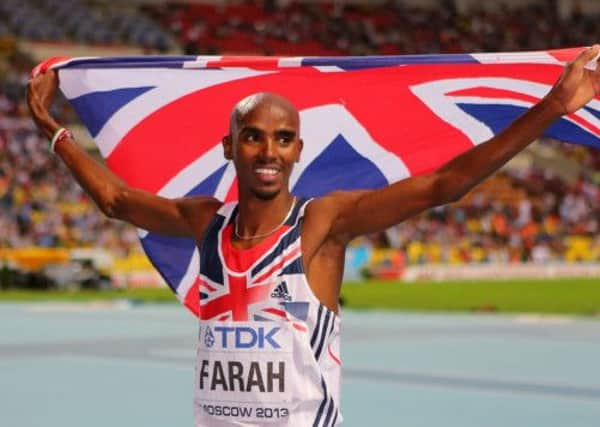Alan Watkinson: Sporting partnership that guided Mo to gold


His performance was heralded as a triumph for multicultural Britain, and his attitude and manner were lauded as an example for all sportsmen and – women – everywhere. His firm but polite response to the question about whether he would rather be competing for Somalia (his country of birth) – “Not at all, mate. This is my country” – was met with universal approval.
Mo is indeed a product of the British system, a west London comprehensive schoolboy nurtured through our school and club athletics infrastructure. His post-race comment, “it’s all about hard work and grafting”, was a gift to assembly-writing teachers across the breadth of the country. However, while “hard work and grafting” form a large part of his success story, Mo has had to overcome many substantial barriers that have threatened to dislodge him from his destiny.
Advertisement
Hide AdAdvertisement
Hide AdIt was my pleasure and privilege to assist him in confronting these barriers. I have been asked many times about how I spotted Mo and have received many plaudits for this phenomenal achievement. In all honesty, picking out his ability was unremarkable. In the same way as it does not take a genius to recognise that our primary school physical education offer is at best patchy and at worst woefully inadequate, it was pretty obvious that Mo could run. However, it is what followed this recognition that is significant.
The first decade of the 21st century witnessed a transformation of PE and school sport in this country. In their subject report for physical education, Ofsted reported: “PE is generally in good health. Considerable investment over the last decade has ensured PE is a central part of school life for pupils of all ages.”
The past decade’s successes can be attributed to the development of school sport partnerships (SSPs) and other strategies. Mo’s school experience predated the SSP system, but the principles that underpin the success of SSPs are firmly evident in his development. The strong school-to-club link existed, without which Mo’s initial experiment with running would in all probability have come to an early end.
Relationships with his peers, his coach and me, as his head of year/PE teacher/mentor, enabled a nurturing of his early athletic experiences that are not normally possible without strong family support.
Advertisement
Hide AdAdvertisement
Hide AdOlympic glory was 18 years in the making, and those first few years established strong foundations on which this fine talent could be built to perfection. Mo moved on to more sophisticated structures of support and to far more advanced systems that sustained his development. Without the creation and evolution of these structures and systems, and without the relationships and responsibilities within these, Mo would not have come close to his remarkable achievements. Without all this, the pride in his success that we feel as a nation and the warm glow it affords would not exist.
Because of the development of sports colleges and the SSP system, there are many examples of outstanding practice in all areas of physical education and sport throughout this country. These are the foundations on which we can build a world-class system for all. The structure and systems led by the Youth Sport Trust allowed opportunities for this practice to be shared and a large number of strong relationships and communities of practice to be developed countrywide.
The most stunning example of this working can be seen in leadership and volunteering programmes nationwide, which have formed the foundation of a booming intra-school competition programme and have provided life-changing opportunities for countless young people.
It would be churlish and wrong to decry the recent announcement that £150m a year would be invested in primary school physical education and school sport.
Advertisement
Hide AdAdvertisement
Hide AdIn a time of economic uncertainty, it shows recognition of the importance of addressing the deep-rooted challenges faced in primary schools, it raises the profile and importance of the development of physical literacy, and it establishes this at the heart of the battle against childhood obesity.
Ring-fencing the money, and utilising Ofsted to hold schools to account for their PE and sport offer, are enlightened and welcome developments. In areas that are well served with expertise and capacity, this initiative will almost certainly have a significant impact, and the very good and outstanding will go from strength to strength.
However, accountability and responsibility should not rest solely with head teachers. This does not provide a robust and rigorous system and adds to an already overburdened workload for school leaders. Because of local authority cuts they are unlikely to have the support of a PE adviser, and in a lot of areas functional SSPs no longer exist.
By not supporting the development of advanced structures and systems, the coalition Government has left this to individual endeavour and enterprise.
Advertisement
Hide AdAdvertisement
Hide AdWhile I understand the political philosophy that underpins this, it leaves to chance the development of our children’s physical literacy, it leaves to chance the ability of our teachers to instil in all children a love of physical activity and sport, and it leaves too much to chance in addressing the obesity time bomb that confronts us.
Transforming primary school physical education and school sport is a considerably more involved and complex challenge, and without a partnership approach and a mixture of shared and definitive responsibility, success will be limited.
*Alan Watkinson was Mo Farah’s PE teacher and one of the contributors to ‘The Future of School and Community Sport’ published this week by the Smith Institute. This is an edited extract.